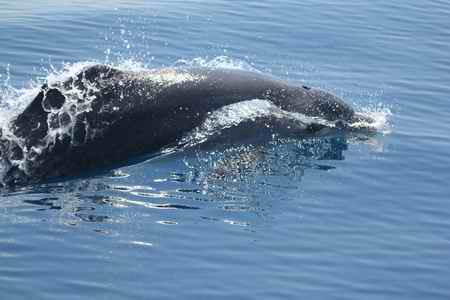
Having joined the MCR team as office assistant in early 2013, I knew plenty about the vital research that takes place on SOTW, but I never thought I would have the chance to participate myself. However in early July the team found themselves a member down for the start of the Aegean harbour porpoise survey and I jumped at the chance to join the boat. Along with cetacean researchers from both Greece and Turkey I joined the existing group of six, and the ten of us set sail from Athens on the morning of the 5th July.
For the next two weeks we would primarily be surveying the North Aegean waters off the coasts of Greece and Turkey looking for harbour porpoises. These waters have produced only two live sightings in the last 15 years. We are hoping to use both visual and acoustic observations to obtain a population estimate. The Greek philosopher and naturalist Aristotle gave the species the name Phocena, describing its morphology in detail, separating them from dolphins. Interestingly however, even though he was based in the northern Aegean Sea, he made no reference to sightings in this region and mentioned the Black Sea only, where to date there is still an established, although Endangered, sub population. During the first section of the survey the team was pleased to be able to confirm the presence of harbour porpoises, with a number of sightings in the Turkish waters of the northern Aegean. Post survey analysis will reveal if we also had any acoustic detections.
As well as harbour porpoise sightings we have had some great dolphin sightings, including a mixed group of bottlenose and common dolphins. While it is not unusual to see mixed groups, the smaller dolphin species tend to stay away from their more robust cousins, the bottlenose. Within this group we were privileged to see a new bottlenose calf still with visible foetal folds, there were also some adults with visible scarring and one that was missing its entire dorsal fin. We had a night-time visit from some common dolphins, and it was amazing to see them bowriding in the moonlight and bioluminescence.
We are now heading into port in Kavala for a crew change, but when the boat heads out again, the team will continue looking for the harbour porpoise, before they turn their attention to the endangered eastern Mediterranean sperm whale population.
Clare Gibson
Clare has a Marine Biology degree from Bangor University and has spent the last few years on the Hebridean Island of Mull working with whale watching operators and enjoying the rugged landscape.
Dear Techie Kids,The video you posted is fintastac for hearing all the different clicks and whistles that dolphins make! It is pretty amazing that they can tell where fish are, and where they are going, just by listening to the echo that bounces off them.One interesting fact about dolphins is they sleep by resting just one half of their brain at a time, with one eye open. This way they can see if predators are coming and they can also rise to the surface to breathe while they are asleep!I lived in the tropical country of Belize for about a year so I got to see some dolphins, but lots of bats! Belize has lots of rainforest covered hills with limestone caves in them, and I explored some of the caves. There were always bats hanging from the ceiling that I could look at close up with my headlamp. Some of them would be flying around in the cave in total darkness, and they would zoom right in front of me. All of a sudden I would see them flash through the light from my headlamp, just inches from my face. It was very cool!Thanks for another excellent post!Your blogging buddy,Mr. Salsich